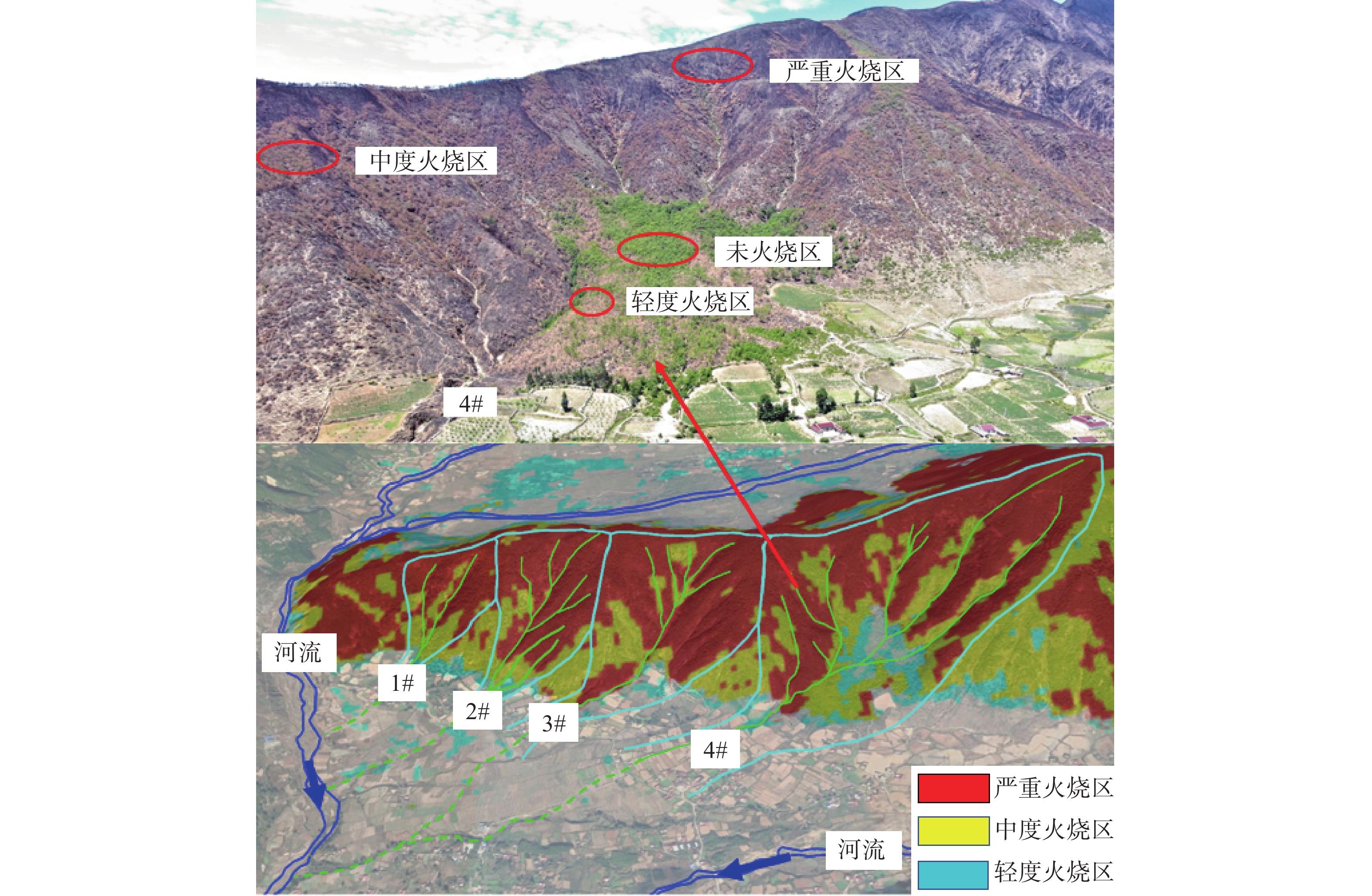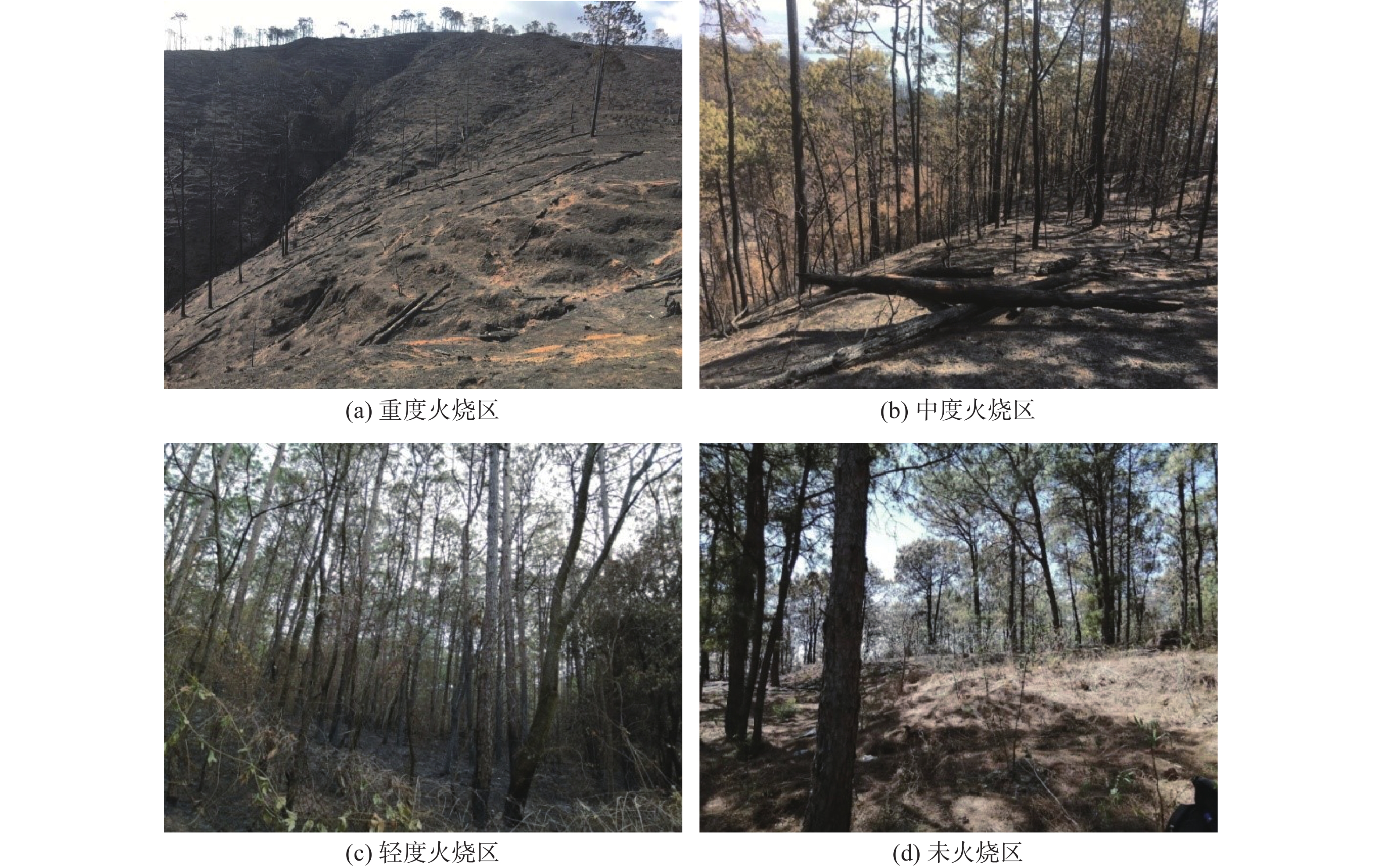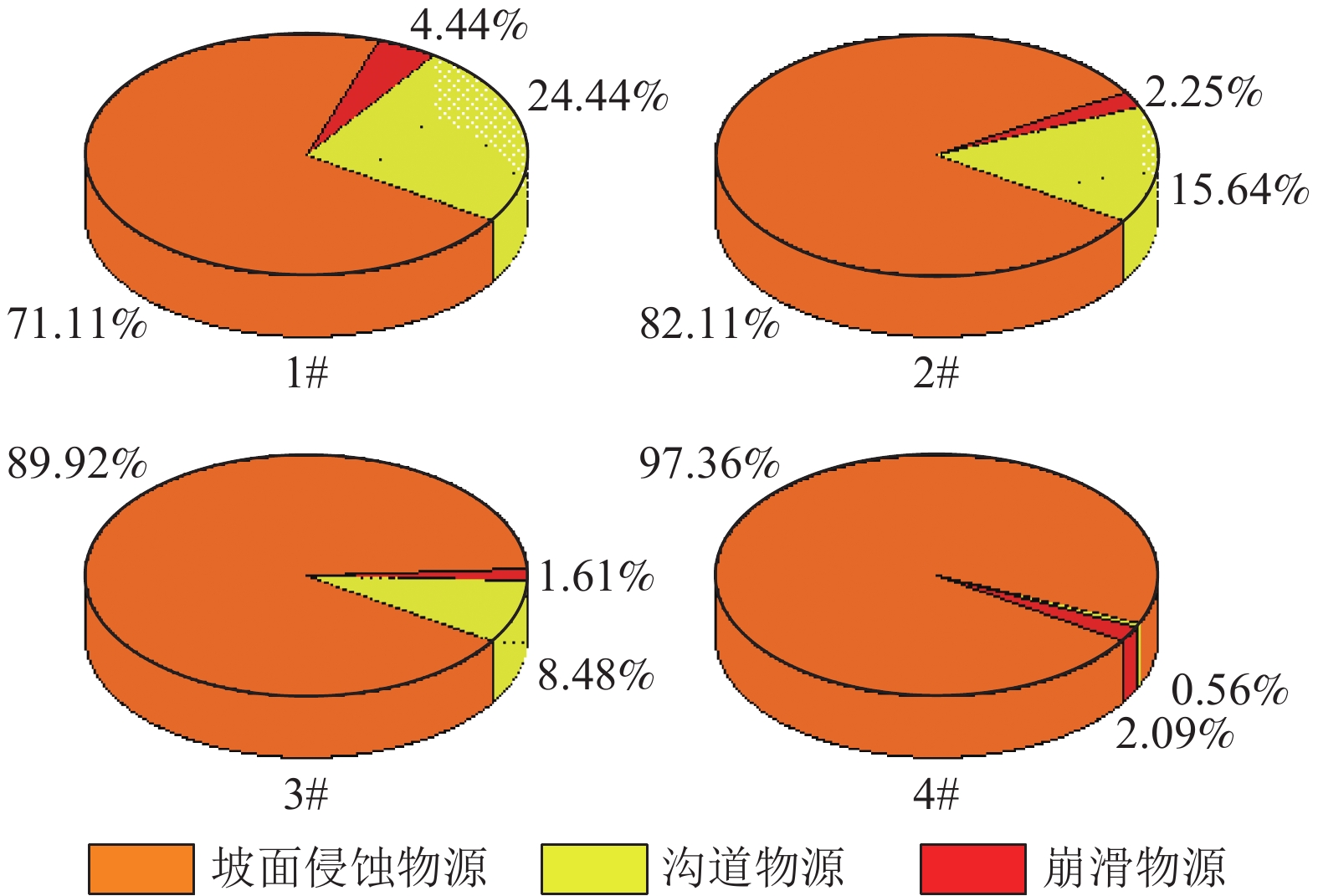Study on the development characteristics of post-fire debris flow and its early warning risk aversion in Zhongba Village, Xide County
-
摘要:
2020年5月7日四川省凉山彝族自治州喜德县鲁基乡中坝村发生森林火灾,过火面积约6.7 km2。林火后火烧迹地坡面灰烬厚约2~6 cm,同时表层土壤结构被扰动,在6月4日傍晚20 min左右的强降雨下,中坝村后山4条沟道同时暴发了火后泥石流灾害,对沟口的41户164名居民构成严重威胁。通过遥感解译、野外调查,查明了火烧区4条沟道的火烈度及物源分布特征,分析了火后泥石流的发育特征,并进行了危险度评估。基于火后泥石流暴发降雨阈值、实时雨量监测数据与群测群防于一体,提出了一套适用于山区火后泥石流的预警避险方案,在该沟得到成功应用,并确保了沟口居民安全。
Abstract:On May 7, 2020, a forest fire broke out in Zhongba Village, Luji Township, Xide County, Liangshan Yi Autonomous Prefecture, Sichuan Province, covering an area of about 6.7 km2. After the forest fire, the ash on the slope was about 2~6 cm thick, and the surface soil structure was disturbed. Under the heavy rainfall of about 20 min in the evening of June 4, the post-fire debris flow disaster broke out in the four gullies at the back mountain of Zhongba Village, which is a great threat to the 164 residents of 41 households in the gully mouth. Through remote sensing interpretation and field investigation, the fire intensity and deposit distribution characteristics of four gullies in the burned area are identified, the development characteristics of post-fire debris flow in Zhongba Village, Xide County are analyzed, and the risk assessment is carried out. Based on the real-time rainfall data obtained from group survey and group prevention, a set of early-warning and risk avoidance scheme for debris flow in mountain areas after fire is proposed, which has been verified by this example.
-

-
表 1 中坝村后山火烧迹地不同强度火烈度判别特征
Table 1. Distinguishing characteristics of fire intensity of different intensity in Zhongba Village burned area
火强度 特点 未火烧 火烧前后地表覆盖物无变化 轻度火烧 超过50%的枯枝落叶未完全燃烧 中度火烧 大部分枯枝落叶被烧毁,但是大部分粗可燃物未完全燃烧 严重火烧 枯枝落叶和粗可燃物均被完全烧毁,地表为灰烬覆盖 表 2 中坝村森林火烧区不同火烈度面积占比数据统计
Table 2. Statistics on the proportion of different fire intensity areas in the forest fire area of Zhongba Village
/% 火烧区 轻度火烈度区面积占比 中度火烈度区面积占比 重度火烈度区面积占比 中度及重度火烈度区面积占比 整个火烧迹地 14.31 19.76 65.93 85.69 1#沟 2.11 26.56 69.41 95.97 2#沟 3.69 16.94 78.37 95.32 3#沟 3.18 18.51 74.78 93.28 4#沟 7.36 26.52 63.82 90.33 表 3 火烧区4条泥石流沟形态特征统计
Table 3. Morphological characteristics statistics of 4 debris flow ditches in burned area
沟道编号 流域面积/km2 主沟长/km 主沟纵坡比降/‰ 相对高差/m 岸坡坡度/(°) 沟谷形状 1# 0.13 0.652 450 244 40~50 “V”形 2# 0.23 0.893 429 317 40~50 “V”形 3# 0.36 1.040 360 326 35~45 “V”形 4# 0.73 2.090 311 395 35~45 “V”形 表 4 火烧区各泥石流沟动、静储量统计
Table 4. Statistics of dynamic and static reserves of debris flow gully in burned area
/(×104 m3) 沟号 物源储量 崩滑物源 沟道物源 坡面侵蚀物源 总计 1#沟 静储量 1.10 0.20 3.20 4.50 动储量 0.33 0.06 0.32 0.71 2#沟 静储量 1.60 0.23 8.40 10.23 动储量 0.48 0.07 1.10 1.65 3#沟 静储量 1.32 0.25 14.00 15.57 动储量 0.39 0.08 2.00 2.47 4#沟 静储量 0.75 0.20 35.00 35.95 动储量 0.22 0.06 4.80 5.08 表 5 中坝村不同频率降雨强度值
Table 5. Rainfall intensity values of different design frequencies in Zhongba Village
降雨时段/h 设计频率/% 20 10 5 3.33 2 1 H1/6P 19.23 23.02 26.63 28.69 31.23 34.63 H1P 45.70 55.95 65.86 71.55 78.64 88.14 H6P 86.73 107.16 127.01 138.45 152.72 171.89 H24P 90.43 109.23 127.25 137.54 150.32 167.40 表 6 中坝村2020年“6·4”泥石流暴发实时降雨量监测数据
Table 6. Real-time rainfall monitoring data of 6·4 debris flow outbreak in Zhongba Village in 2020
雨量站位置 距中坝村距离/
km10 min雨量/
mm1 h雨量/
mm漫水湾镇松林村1-4组 4.5 11.7 15.4 表 7 中坝村火后泥石流各沟道沟口平均流速计算结果
Table 7. Calculation results of the average flow velocity of each channel gully of post-fire debris flow in Zhongba Village
沟道编号 1# 2# 3# 4# 泥深/m 1.3 1.4 1.6 1.0 主沟纵坡降/‰ 450 429 360 311 平均流速/(m·s−1) 7.85 7.28 8.04 7.03 表 8 中坝村2020年6·4火后泥石流峰值流量计算结果
Table 8. Calculation results of peak flow of 6·4 post-fire debris flow in Zhongba Village in 2020
沟道编号 1# 2# 3# 4# 平均流速/(m·s−1) 7.85 7.28 8.04 7.03 计算断面面积/m2 5.88 11.56 11.31 2.75 峰值流量/(m3·s−1) 46.17 74.19 90.92 19.33 表 9 中坝村1#~4#沟道沟域基础数据
Table 9. Basic data of 1#~4# trench trench area in Zhongba Village
沟道编号 泥石流规模m/
(103 m3)暴发频率f/
(次·100年−1)流域面积s1/
km2主沟长度s2/
km流域相对高差s3/
km流域切割密度s6/
km不稳定沟床比例s9/
%1# 6.30 32.43 0.130 0.652 0.244 9.33 76 2# 11.40 28.73 0.230 0.893 0.317 9.04 85 3# 12.30 27.98 0.360 1.040 0.326 9.00 80 4# 2.60 56.15 0.730 2.090 0.395 11.40 65 表 10 中坝村泥石流1#~4#沟危险度评价
Table 10. Evaluation of dangerous degree of ditch 1#~4# in Zhongba Village
沟道编号 1# 2# 3# 4# 泥石流规模M/103 m3 0.266 0.352 0.363 0.138 暴发频率F/(次·100年−1) 0.756 0.729 0.723 0.875 流域面积S1/km2 0.085 0.130 0.160 0.225 主沟长度S2/km 0.175 0.285 0.296 0.416 流域相对高差S3/km 0.163 0.211 0.217 0.379 流域切割密度S6/km 0.466 0.452 0.450 0.570 不稳定沟床比例S9/% 1 1 1 1 评价结果 0.42 0.45 0.46 0.48 表 11 单沟泥石流危险度分级标准
Table 11. Classification standard of danger degree of single ditch debris flow
单沟泥石流危险度 0.0~0.2 0.2~0.4 0.4~0.6 0.6~0.8 0.8~1.0 危险度分级 极低危险 低危险度 中危险度 高危险度 极高危险 -
[1] 邸雪颖, 陶玉柱. 火后泥石流研究进展[J]. 应用生态学报,2013,24(8):2383 − 2392. [DI Xueying, TAO Yuzhu. Research progress in post-fire debris flow[J]. Chinese Journal of Applied Ecology,2013,24(8):2383 − 2392. (in Chinese with English abstract)
[2] 任云, 胡卸文, 王严, 等. 四川省九龙县色脚沟火后泥石流成灾机理[J]. 水文地质工程地质,2018,45(6):150 − 156. [REN Yun, HU Xiewen, WANG Yan, et al. Disaster mechanism of the Sejiao post-fire debris flow in Jiulong County of Sichuan[J]. Hydrogeology & Engineering Geology,2018,45(6):150 − 156. (in Chinese with English abstract)
[3] 胡卸文, 王严, 杨瀛. 火后泥石流成灾特点及研究现状[J]. 工程地质学报,2018,26(6):1562 − 1573. [HU Xiewen, WANG Yan, YANG Ying. Research actuality and evolution mechanism of post-fire debris flow[J]. Journal of Engineering Geology,2018,26(6):1562 − 1573. (in Chinese with English abstract)
[4] CANNON S H, RENEAU S L. Conditions for generation of fire‐related debris flows, Capulin Canyon, New Mexico[J]. Earth Surface Processes and Landforms,2000,25(10):1103 − 1121. doi: 10.1002/1096-9837(200009)25:10<1103::AID-ESP120>3.0.CO;2-H
[5] CANNON S H, GARTNER J E. Wildfire-related debris flow from a hazards perspective[J]. Debris-flow Hazards and Related Phenomena,2005:363 − 385.
[6] 王严, 胡卸文, 金涛, 等. 火后泥石流形成过程的物源启动模式研究[J]. 工程地质学报,2019,27(6):1415 − 1423. [WANG Yan, HU Xiewen, JIN Tao, et al. Material initiation of debris flow generation processes after hillside fires[J]. Journal of Engineering Geology,2019,27(6):1415 − 1423. (in Chinese with English abstract)
[7] STALEY D M, NEGRI J A, KEAN J W, et al. Prediction of spatially explicit rainfall intensity-duration thresholds for post-fire debris-flow generation in the western United States[J]. Geomorphology,2017,278(FEB. 1):149 − 162.
[8] WALL S A, ROERING J J, RENGERS F K. Runoff-initiated post-fire debris flow Western Cascades, Oregon[J]. Landslides,2020,17(7):1649 − 1661. doi: 10.1007/s10346-020-01376-9
[9] NYMAN P, SMITH H G, SHERWIN C B, et al. Predicting sediment delivery from debris flows after wildfire[J]. Geomorphology,2015,250:173 − 186. doi: 10.1016/j.geomorph.2015.08.023
[10] PARISE M, CANNON S H. Wildfire impacts on the processes that generate debris flows in burned watersheds[J]. Natural Hazards,2012,61(1):217 − 227. doi: 10.1007/s11069-011-9769-9
[11] SANTI P M, DEWOLFE V G, HIGGINS J D. Sources of debris flow material in burned areas[J]. Geomorphology,2008,96(3/4):310 − 321.
[12] GABET E J, STERNBERG P. The effects of vegetative ash on infiltration capacity, sediment transport, and the generation of progressively bulked debris flows[J]. Geomorphology,2008,101(4):666 − 673. doi: 10.1016/j.geomorph.2008.03.005
[13] 任云. 四川九龙县色脚沟火后泥石流成灾机理及危险性评价[D]. 成都: 西南交通大学, 2018.
REN yun. The disaster mechanism and risk assessment of sejiao post-fire debris flow in jiulong, sichuan[D]. Chengdu: Southwest Jiaotong University, 2018. (in Chinese with English abstract)
[14] 孙佳佳, 于东升, 史学正, 等. 植被叶面积指数与覆盖度定量表征红壤区土壤侵蚀关系的对比研究[J]. 土壤学报,2010,47(6):1060 − 1066. [SUN Jiajia, YU Dongsheng, SHI Xuezheng, et al. Comparison of between Lai and vfc in relationship with soil erosion in the red soil hilly region of South China[J]. Acta Pedologica Sinica,2010,47(6):1060 − 1066. (in Chinese with English abstract) doi: 10.11766/trxb200910150458
[15] MILLER J D, THODE A E. Quantifying burn severity in a heterogeneous landscape with a relative version of the delta Normalized Burn Ratio (dNBR[J]. Remote Sensing of Environment,2007,109(1):66 − 80. doi: 10.1016/j.rse.2006.12.006
[16] 王晓莉, 王文娟, 常禹, 等. 基于NBR指数分析大兴安岭呼中森林过火区的林火烈度[J]. 应用生态学报,2013,24(4):967 − 974. [WANG Xiaoli, WANG Wenjuan, CHANG Yu, et al. Fire severity of burnt area in Huzhong forest region of Great Xing'an Mountains, Northeast China based on normalized burn ratio analysis[J]. Chinese Journal of Applied Ecology,2013,24(4):967 − 974. (in Chinese with English abstract)
[17] PARSONS A, ROBICHAUD P, LEWIS S A, et al. Field guide for mapping post-fire soil burn severity[R]. General Technical Report RMRS-GTR-243. USDA Forest Service, Rocky Mountain Research Station: Fort Collins, CO, USA, 2010.
[18] 陈子龙. 仁额拥沟火后泥石流发育特征及成因机制研究[D]. 成都: 成都理工大学, 2016.
CHEN Zilong. Reasearch on development characteristics and genetic mechanism of the post-fire debris flow in Reneyong ravine[D]. Chengdu: Chengdu University of Technology, 2016. (in Chinese with English abstract)
[19] 李明威, 唐川, 陈明, 等. 汶川震区北川县泥石流流域崩滑体时空演变特征[J]. 水文地质工程地质,2020,47(3):182 − 190. [LI Mingwei, TANG Chuan, CHEN Ming, et al. Spatio-temporal evolution characteristics of landslides in debris flow catchment in Beichuan County in the Wenchuan earthquake zone[J]. Hydrogeology & Engineering Geology,2020,47(3):182 − 190. (in Chinese with English abstract)
[20] 刘佳, 赵海军, 马凤山, 等. 基于改进变异系数法的G109拉萨—那曲段泥石流危险性评价[J]. 中国地质灾害与防治学报,2020,31(4):63 − 70. [LIU Jia, ZHAO Haijun, MA Fengshan, et al. Risk assessment of G109 Lhasa-Naqu Debris flow based on improved coefficient of variation[J]. The Chinese Journal of Geological Hazard and Control,2020,31(4):63 − 70. (in Chinese with English abstract)
[21] 翟淑花, 冒建, 南赟, 等. 基于遗传规划的泥石流多因子融合预测方法[J]. 中国地质灾害与防治学报,2020,31(6):111 − 115. [ZHAI Shuhua, MAO Jian, NAN Yun, et al. Multi-factors fusion method of debris flow prediction based on genetic programming[J]. The Chinese Journal of Geological Hazard and Control,2020,31(6):111 − 115. (in Chinese with English abstract)
[22] 刘希林. 沟谷泥石流危险度计算公式的由来及其应用实例[J]. 防灾减灾工程学报,2010,30(3):241 − 245. [LIU Xilin. Quantitative assessment on site-specific debris flow hazard and application[J]. Journal of Disaster Prevent and Mitigation Engineering,2010,30(3):241 − 245. (in Chinese with English abstract)
-




 下载:
下载:





